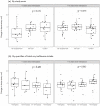A Randomized Controlled Trial of Soy Isoflavone Intake on Mammographic Density among Malaysian Women
- PMID: 36678170
- PMCID: PMC9862880
- DOI: 10.3390/nu15020299
A Randomized Controlled Trial of Soy Isoflavone Intake on Mammographic Density among Malaysian Women
Abstract
Soy intake is associated with lower breast cancer risk in observational studies concerning Asian women, however, no randomized controlled trials (RCT) have been conducted among Asian women living in Asia. This three-armed RCT assessed the effects of one-year soy isoflavone (ISF) intervention on mammographic density (MD) change among healthy peri- and postmenopausal Malaysian women. This study was registered at ClinicalTrials.gov (NCT03686098). Participants were randomized into the 100 mg/day ISF Supplement, 50 mg/day ISF Diet, or control arm, and assessed for change in absolute and relative dense area from digital mammograms conducted at enrolment and after 12 months, compared over time across study arms using Kruskal-Wallis tests. Out of 118 women enrolled, 91 women completed the intervention, while 27 women (23%) were lost in follow up. The ISF supplement arm participants observed a larger decline in dense area (−1.3 cm2), compared to the ISF diet (−0.5 cm2) and control arm (−0.8 cm2), though it was not statistically significant (p = 0.48). Notably, among women enrolled within 5 years of menopause; dense area declined by 6 cm2 in the ISF supplement arm, compared to <1.0 cm2 in the control arm (p = 0.13). This RCT demonstrates a possible causal association between soy ISF intake and MD, a biomarker of breast cancer risk, among Asian women around the time of menopause, but these findings require confirmation in a larger trial.
Keywords: Soy isoflavones; breast cancer; mammographic density; randomized controlled trial.
Conflict of interest statement
The authors declare no conflict of interest.
Figures


References
-
- Sung H., Rosenberg P.S., Chen W.Q., Hartman M., Lim W.Y., Chia K.S., Wai-Kong Mang O., Chiang C.J., Kang D., Ngan R.K.C., et al. Female Breast Cancer Incidence among Asian and Western Populations: More Similar Than Expected. J. Natl. Cancer Inst. 2015;107:djv107. doi: 10.1093/jnci/djv107. - DOI - PMC - PubMed
Publication types
MeSH terms
Substances
Associated data
Grants and funding
LinkOut - more resources
Full Text Sources
Medical

